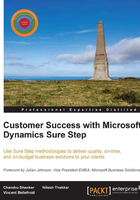
Chapter 1. Background and Concepts
One of the biggest criticisms leveled at ERP systems (or any integrated application suite based on best-practice functionality) is that they are inflexible and don't support business change. Gartner finds that in too many cases any perceived inflexibility is due more to the way ERP applications have been purchased and deployed than to any inherent flaws in the technology.
Gartner, Inc., Jan 2012
The success of a business solution, and specifically Enterprise Resource Planning (ERP) and Customer Relationship Management (CRM) solutions, isn't solely about technology. Experience tells that it is as much about the people and processes as it is about the software. Software is only the enabler, with the key to success lying in developing an organizational solution strategy to fit the near-term and long-term goals of the company, matching the needs to appropriate solutions, and then managing the implementation to meet the set goals.
When organizations think of ERP and CRM systems, they typically think of core financials and bookkeeping functions or the basic customer contact management activities. While these systems certainly can and do support those functions, it is also important to understand the capabilities that the modern-day versions of these solutions are starting to provide to companies and their user base. These systems have evolved well beyond these basic foundations, encompassing multiple functional, departmental, and cross-functional needs of the organizations. Current generation business solutions are capable of providing composite applications that support areas including product engineering, sales force automation, marketing automation, customer care, sales order management, supplier relationship management, supply chain planning, order fulfillment and logistics, and after-sales service and support.
Given the wide range of capabilities that the modern-day systems offer, it is very important for organizations to be methodical in building a strategy and tailoring their approach to learning about the solution functionalities that are available and matching them to specific needs in specific areas of the company. One of the best research models in recent times to help organizations build a successful solution strategy is the Gartner Pace Layer Model. This chapter will introduce the reader to this model, and explain how it can help organizations investigating business systems for their needs.
Microsoft has always understood that its customers will achieve maximum value from their software investments only if the solution is a good fit to the customer requirements, and the solution is implemented to meet the needs of the users. With this vision in mind, Microsoft developed and introduced the Microsoft Dynamics Sure Step methodology, to help service providers correctly position and deploy the Microsoft Dynamics ERP/CRM suite of products—AX, CRM, GP, NAV, and SL. Sure Step is a vehicle that facilitates the partnership of consulting and customer resources, representing a very important triangulation of the collaboration between the software vendor, implementer, and customer, with the implementation methodology becoming a key element of the implemented application.
In this chapter, we will introduce the concepts and definitions used in this book, and lay the background for the ensuing chapters. We will also provide an overview of Microsoft Dynamics Sure Step, and the different aspects of the methodology that help both the implementer and the customer.